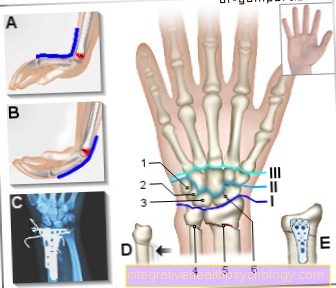Ultrasound of the abdomen (Sono Abdomen)
definition
The ultrasound scan of the abdomen, often called Sono abdomen This is a standard diagnostic procedure that can be helpful in dealing with various questions. On the one hand, it is used to find the cause of various complaints and, on the other hand, it can be indicated as a check-up in the follow-up care of diseases. The method does not pose any risks and the necessary equipment is available relatively often. However, only certain properties and possible diseases of the abdominal organs can be detected or excluded. More advanced procedures are often necessary for a diagnosis. In addition, certain factors make the examination conditions difficult for the patient, such as obesity and air pockets in the abdomen.
.jpg)
Indications
An ultrasound examination of the abdomen can show some organs very well and detect possible pathological changes. Some organs, on the other hand, can only be assessed to a limited extent and others can hardly be examined with Sono Abdomen. Therefore, there are various indications for which an ultrasound of the abdomen is useful. These include, for example, certain diseases of the liver and the biliary tract and the gallbladder.
Gallstones and an expansion of the duct system can be shown. Inflammations can be easily recognized in the ultrasound image. Diseases of the liver and biliary system are often expressed by right-sided upper abdominal pain, so that the indication for a Sono abdomen is justified with these symptoms. Furthermore, the kidney and the urinary tract can be scanned if the doctor suspects a kidney stone as a trigger due to cramp-like pain, for example. In some cases, the cause of the discomfort can be identified with an ultrasound of the abdomen.
Further indications arise if the physician suspects an inflamed appendix or an ovarian cyst as the cause, based on the symptoms expressed and the physical examination. In many cases, however, the Sono Abdomen does not allow a reliable statement to be made as to whether or not there is a pathological change. The results of the examination must always be assessed in conjunction with the other findings. Due to the partially limited ability to assess the organs, a Sono Abdomen is only indicated for a specific question about which the examination can also provide information. In contrast, unspecific complaints are usually not an indication.
Read more about the topics: Water in the abdomen, peritonitis, ruptured spleen
But ultrasound can also be used for therapeutic purposes and has a wide variety of uses. If you are interested, read more about this under: Ultrasound in therapy
Ultrasound for cancer
For many cancers, the ultrasound examination of the abdomen is an important part of diagnosis and follow-up care. Many types of cancer often spread to the liver so that the Sono Abdomen can determine or rule out whether daughter tumors (Metastases) exist or not. On the one hand, this is relevant for the initial diagnosis, since metastasis influences the therapeutic options and prognosis of the disease. On the other hand, after a therapy, it can be checked whether new cancerous ulcers are growing again, so that a new therapy can be initiated in good time.
In some cancers, such as pancreatic cancer or colon cancer, the original tumor in the abdomen can be detected through the Sono abdomen. However, other examinations, such as computed tomography, are much better suited for this, so that if there is a suspicious abnormality in the sono-abdomen, they are usually used for more precise clarification.
preparation
No special preparation is necessary for the Sono Abdomen. Even if the patient does not have to fast, it is advisable not to consume large meals or carbonated drinks before the examination. Otherwise, the examination conditions are negatively influenced by gas accumulations in the gastrointestinal tract. If necessary, you should go to the toilet again before the examination, unless otherwise stated by the examiner. It is also an advantage to choose clothing that allows easy exposure of the entire abdomen down to the groin.
procedure
For the ultrasound examination of the abdomen, the patient usually takes a supine position on the examination table. The patient should lie as relaxed as possible during the examination. If necessary, bending your legs can help relax the abdominal wall. The examiner will ask you to clear your stomach. As a rule, it is sufficient to pull the clothing up or down accordingly.
Then an ultrasound gel is applied to the abdomen. This feels cool and damp. Then the actual examination begins, as the doctor places the ultrasound head on the skin. Now either a specific region of the abdomen oran organ is visited and displayed or a systematic examination of all organs located in the abdomen and displayed by the Sono Abdomen is carried out. These include, for example, the liver, spleen, kidneys and bladder. If necessary, the doctor will ask the patient to change his position or to carry out certain breathing maneuvers.
Read more on the topic: Ultrasound of the urinary bladder
With the help of special settings of the ultrasound device, the examiner can also carry out special measurements, such as determining the size of an organ. The transducer is usually guided with gentle pressure, which is usually not perceived as painful or uncomfortable. However, if pain does occur, it is advisable to inform the doctor directly.
Read more about the topics: Ultrasound of the testicle, ultrasound of the breast, ultrasound in pregnancy
Evaluation / diagnosis
With the Sono Abdomen, as with any ultrasound procedure, there is a real-time display, i.e. the examiner sees the images of the examined region during the examination. The evaluation therefore begins with the examination itself. For example, the size of an organ can be measured directly or an inflammatory change in the gallbladder or pancreas can be displayed and documented by saving or printing images.
After the examination has been completed, all organs examined are assessed in writing based on the images recorded. The findings are documented in the patient file and, depending on what has been agreed, sent to the family doctor, the doctor who requested the examination or the patient, for example by post.
Risks
One of the great advantages of having an abdominal ultrasound scan is that it is completely risk-free. The ultrasonic waves used in the process have no negative impact on the human body and, in contrast to X-rays, for example, have no health consequences even if they are used more frequently.
Duration
The duration of the actual examination for the Sono Abdomen depends on the one hand on the question and on the other hand on the sound conditions, i.e. how well the patient's organs can be visualized. The experience of the examiner also has an influence on the duration. An ultrasound of the abdomen usually takes about 15 to 20 minutes. Possible waiting times before the examination are not included.
costs
If an ultrasound examination of the abdomen is medically justified, the costs will be covered in full by the health insurance. However, in many practices it is also possible to have the examination carried out at your own request. It is then a so-called IGEL service (individual health service), for which the patient has to pay himself. Expect costs of around € 50. However, the prices can vary greatly depending on the practice and should be asked in advance.
How far do you have to pull yourself off from your stomach for an ultrasound?
With ultrasound from the abdomen, it is often not necessary to undress at all. It only needs to be guaranteed that the entire belly can be cleared from below the chest to the groin. It is therefore sufficient to undress to your undershirt or T-shirt and pull it up. Even the pants only need to be pulled down to above the genital area and opened if necessary. The underwear can always be kept on with a Sono Abdomen. In order to avoid soiling the clothing with the examination gel, pants or tops can be covered with disposable towels.
Overweight problem
Various factors on the part of the patient can complicate the examination conditions. A common problem is being overweight. In order for the ultrasound process to produce a usable image, the ultrasound waves have to penetrate human tissue. The thicker the layer of fat that has to be overcome in order to reach the organs, the poorer the image quality and the easier it is to assess. If an adequate assessment by means of ultrasound is not possible in an overweight patient, it can be considered whether another imaging method should be chosen in order to display the organs. Computed tomography (CT) or magnetic resonance tomography (MRT) can be used for this.
Read more on the topic: MRI of the abdomen
Do you have to be sober for the examination?
In order to be able to perform an ultrasound examination of the abdomen, it is not a prerequisite that the patient is sober. However, larger meals should not be eaten before the examination. In particular, foods that swell up, such as cabbage or beans, should be avoided on the day of the examination. If possible, carbonated drinks should also be avoided before the Sono Abdomen. The reason for this is that air pockets in the gastrointestinal tract make the examination conditions difficult. The ultrasound cannot penetrate air well, so that, for example, a loop of the small intestine filled with air obstructs the view of an organ behind it. Since the formation of gas is different in each person, it may also be advisable to repeat the examination on an empty stomach in those with a lot of air in the abdomen.
- Water in the stomach
- Peritonitis
- Rupture of the spleen
- Gallstones
- inflamed appendix
- Ovarian cyst
- Pancreatic cancer
- Colon cancer
- Ultrasound of the testicle
- Ultrasound of the breast
- Ultrasound in pregnancy
- Ultrasound in therapy





























